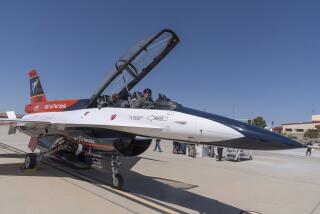‘The Crew Did the Right Thing’ in Peacetime Accident
- Share via
WASHINGTON — Amid fears that Beijing could reap an intelligence windfall from the U.S. spy plane being held on China’s Hainan island, the first murmurs of doubt began circulating in Washington and beyond Wednesday about whether the Navy crew did enough to keep sensitive equipment from falling into the wrong hands.
The second-guessing stretched from the corridors of Washington’s intelligence agencies to the chat rooms of the Internet. Should the pilot have ordered his crew to bail out and then sent the plane plunging into the sea, thereby destroying its sophisticated intelligence-gathering gear? Should the pilot have tried to land on the ocean’s surface, allowing the plane to sink after its 24-member crew had evacuated?
The answer, according to defense experts and pilots who have flown scores of such missions, is that no such extreme action was called for--and probably not feasible--under the circumstances.
“You’re expected to try to get rid of as much classified material as you can,” said Lawrence Korb, an assistant defense secretary in the Reagan administration who flew spy plane missions along the coast of the Soviet Union during the Cold War. “But we’re not at war with China. It’s not a matter of life and death.”
Dan Smith of the Center for Defense Information, a Washington think tank, said: “The question is what’s more valuable--equipment that is sensitive versus the chance of loss of human lives. That’s the balance.”
‘China Not Viewed as Hostile Country’
Retired Air Force Lt. Gen. Richard Burpee, who flew spy plane missions before heading aerial intelligence operations for the Strategic Air Command, agreed. Because the incident occurred in peacetime and “China was not viewed as a hostile country,” Burpee said, endangering the crew or sacrificing lives to protect equipment would not have been appropriate.
“When we were in the Cold War, you might have expected something different. Even Red China was hostile, but it’s not anymore,” he said. “To ask the crew to bail out or ditch the plane under the circumstances is asking an awful lot in today’s environment.
“The first thing an air commander wants to do in an emergency is to get his crew on the ground safely. And if he does, he thinks he did the right thing,” Burpee said, adding, “I think the crew did the right thing.”
Technically, having the crew bail out or attempt a water landing poses serious difficulties and risks, experts said. The plane involved, an EP-3, has a pressurized cabin, which would make parachute evacuation more difficult. So would the unstable movement of a badly damaged plane. Moreover, the EP-3 has relatively narrow wings, making it less suited to water landings.
A former pilot of a similar spy plane, who still works in the Pentagon, told friends Wednesday that, in any case, the Navy plane was too badly damaged to ditch.
“You have got to live through an emergency in an airplane only once to realize what is going on,” Burpee said. “I don’t think we can second-guess the crew. That’s too easy for us to do, sitting back in an armchair with a hot cup of coffee and not having been in their shoes.”
There Was Time to Destroy Sensitive Data
Some U.S. experts also expressed confidence that the crew had succeeded in destroying the most sensitive material in the 10 minutes or so between the time the pilot regained control of the aircraft after it collided Sunday with a Chinese fighter jet and the time it landed on Hainan.
Without minimizing the consequences of having the plane fall into Chinese hands, experts portrayed the loss as less than disastrous.
Although the Defense Department refused to discuss details of the plane’s mission, the equipment it carried or the rules under which it operated, such intelligence work normally includes elaborate precautions for protecting sensitive information and equipment.
The crew of a plane such as the EP-3 is required to have detailed procedures for purging classified material and destroying sensitive equipment. Crews are expected to practice those procedures on a regular basis.
U.S. missions like the one being flown Sunday took place around the world tens of thousands of times during the decades of the Cold War. Planes gathered electronic intelligence on communications, command-and-control systems, air defenses and other subjects. The planes were often challenged by Soviet and Chinese forces and clashed fairly often with them--sometimes with tragic results.
P-3s, cousins of the EP-3, also are routinely used today as part of Washington’s war on drugs.
In the post-Cold War period, the routine nature of the flights--coupled with the reduced stakes--may have dulled the readiness of crews to deal with emergencies, although some experts suggested that China’s recent challenges to U.S. intelligence-gathering planes may have led to renewed caution.
The EP-3 is far more sophisticated than anything the Chinese military possesses, experts said, noting that Beijing’s military lags far behind other major countries in terms of equipment. Chinese specialists can “back-engineer” the captured gear to learn what it can do and what sorts of information the U.S. had been obtaining.
Any Chinese countermeasure is likely to be met in kind by the United States. And--though they were speaking without precise knowledge of this particular plane and what equipment, codes or other sensitive material might have been on board--some experts downplayed the potential impact.
“If they got everything, I don’t think it would be all that significant,” said Korb, the Reagan-era defense official. “It’s not nearly as significant as the stuff Walker gave the Russians,” he said, referring to John A. Walker Jr., the Navy warrant officer who masterminded a family spy ring that provided the Soviet Union with some of the nation’s most sensitive intelligence secrets.










